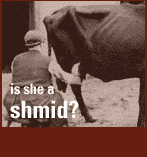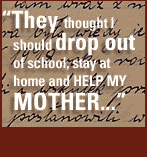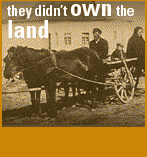

An entire generation: Facing the Future
Growing up brings with it many tough choices and questions. Where do I fit in? Should I listen to my parents, teachers, or my friends. Do I try to make my own way? What is really important in life? And what about the future?
In Jewish communities around the world, learning from elders and studying old Jewish texts were always a central way of renewing meaning and finding guidance. In the interwar period in Europe, Jewish youth were exposed to many new ideas that seemed to translate into new options in life. Combining old and new, the adult Jewish world was blossoming with an array of political options. For the youth it meant exposure to a new variety of schools for Jewish children and later on, a new array of activities that no other youth had before. A new world seemed to opening up. Young people began to feel empowered: dreaming of big possibilities and working towards those dreams that seemed most possible.
Kinderlakh: Children
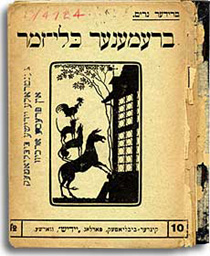

Some things about childhood never seem to change. Children growing up in the USSR, Poland and Lithuania between the world wars did not have electronic games, skateboards or cell phones, but they found many ways to have fun. Whether they lived in a town (shtetl) or a big city (shtot) like Lublin, they played games and sports like soccer or ping-pong, visited grandma's home for Shabes, told stories, and walked in the woods or the park. For Purim  some children might dress up as kings or queens or watch a Purim play (Purim shpil); many loved to follow klezmer
some children might dress up as kings or queens or watch a Purim play (Purim shpil); many loved to follow klezmer  musicians when they played for a wedding or other celebration. They rode in bicycle races, went swimming in the summer and sledding or ice-skating in the winter, sliding on their shoes if they did not own proper skates. In the summer, some went to a Jewish camp for a few weeks, where they sang songs around a bonfire, played sports, put on plays from Bible stories and drew pictures; others joined organized sports clubs like the Maccabi
musicians when they played for a wedding or other celebration. They rode in bicycle races, went swimming in the summer and sledding or ice-skating in the winter, sliding on their shoes if they did not own proper skates. In the summer, some went to a Jewish camp for a few weeks, where they sang songs around a bonfire, played sports, put on plays from Bible stories and drew pictures; others joined organized sports clubs like the Maccabi  (Zionist) or Morgnshtern
(Zionist) or Morgnshtern  (Socialist Bund).
(Socialist Bund).
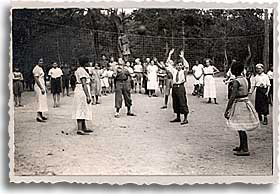

Children and young people did not have as many toys as they do today: their toys were often handmade from wood or cloth, but each toy was treasured. Children played together with their siblings, cousins, neighbors, and in school. During Shabes in shul  , as the Sabbath prayers were chanted in the synagogue, it was a wonderful day to escape from adults and play while working up an appetite to return to a wonderful tsholent (Sabbath stew) that was most often picked up from a local bakery oven where it was left in a designated household pot on Friday evening (erev Shabes).
, as the Sabbath prayers were chanted in the synagogue, it was a wonderful day to escape from adults and play while working up an appetite to return to a wonderful tsholent (Sabbath stew) that was most often picked up from a local bakery oven where it was left in a designated household pot on Friday evening (erev Shabes).







